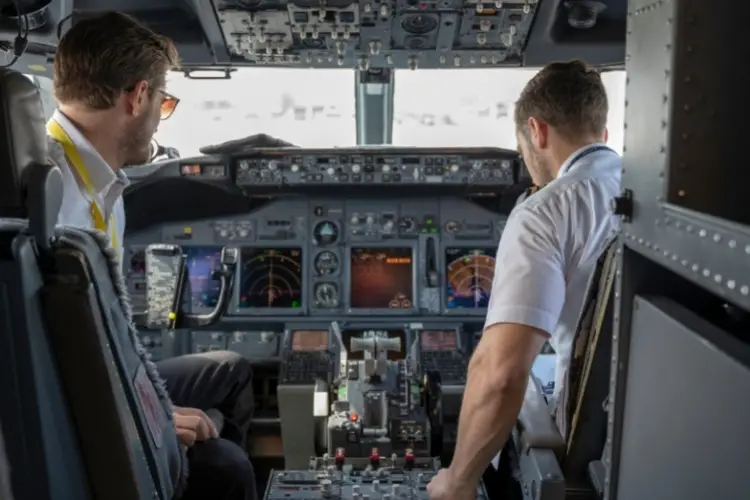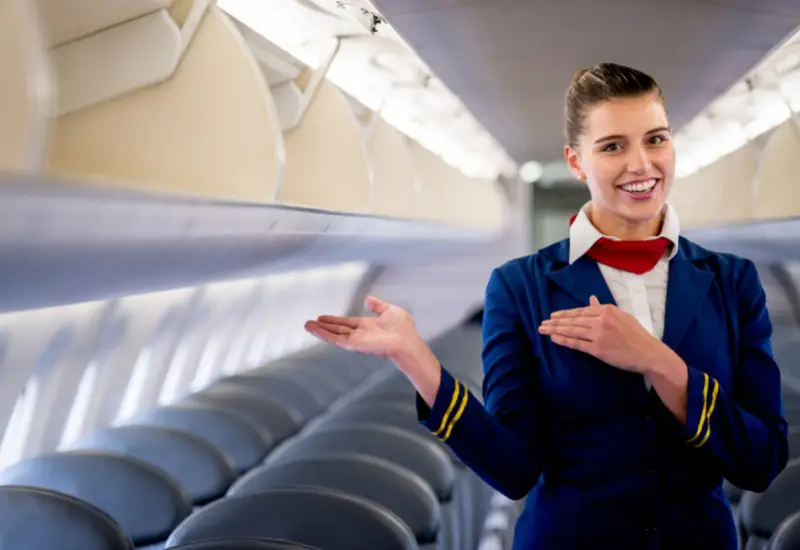Within the flight attendant profession, there aren’t many opportunities to “climb the ladder,” the way you would in other roles. Besides gaining seniority, the only real opportunity for promotion as a flight attendant is to become a Purser.
If you don’t know what a purser is I recommend reading this post: What is a Purser and How Much Do They Earn?
In this post, we will explore how to become a Purser.
Where Does a Flight Purser Fall in the Crew Hierarchy?
Pursers are the “lead” flight attendant on a given flight, meaning they are in charge of the whole crew and report directly to the captain and airline management.
The rest of the crew reports to the Purser.
Pursers are usually among the most senior flight attendants on board the aircraft, but may not necessarily always be the most senior, (depending on the airline and their bidding policies).
Some senior flight attendants don’t want to work as Pursers, so they will happily let a more junior flight attendant pass them up for the role.

Requirements and Qualities Needed to Become a Flight Purser
To become a purser, you will need to satisfy the following qualification requirements:
- You must be currently working as a flight attendant.
- You must be qualified to operate all aircraft in your airline’s fleet.
- You must have experience serving in all class cabins, (Economy, Business, and First).
Additionally, you should have a flawless customer service record and good report with your colleagues.
In other words, your good reputation should precede you.
You should also possess the following professional qualities:
- Leadership skills
- Communication and interpersonal skills
- Coordination and organizational skills
- Conflict resolution
- Ability to multi-task
- Ability to take responsibility
- Problem-solving skills
- (Optional but helpful) Foreign Language skills
Basically, if you regularly get positive feedback from your passengers and co-workers about being a “great flight attendant” you would probably be a good Purser too.
How Do You Become a Flight Purser?
The process to become a Purser differs from airline to airline, but in general, the selection process begins with an internal application process.
You have to already be working for the airline to become a purser.
The exact sequence of events is:
- Put your name in the running for open purser positions
- Complete an internal interview process
- Attend the Purser training program
- Receive your Purser qualifications
- Participate in periodic reviews
How Long Does It Take to Become a Purser?
At some airlines you can apply to become a Purser at any point in your career, others have a minimum experience requirement either in terms of seniority or flight hours.
I know some flight attendants who were able to become Pursers with less than five years of flying experience, but it is more common for Pursers to have twenty-or-more years of experience.
At American Airlines, for example, you are able to sign up to become a Purser at any point, but you will be selected of the “proffer”, (sign up list), based on your seniority. So, even if a more senior flight attendant signs up after you, they will get to go to the top of the list.
Plus, even if a junior flight attendant is able to become Purser qualified, it is unlikely they will actually have many opportunities to work as a Flight Purser.
This is because getting your Purser qualifications is only half of the battle. The other half is “holding” Purser trips.
Since flight attendant trips and positions are awarded based on seniority, junior Pursers are less likely to be able to actually work as the Purser on a flight, because they either:
- Will not hold a trip that has a Purser position.
(In general, only international flights have designated Purser positions). - Will not hold the Purser position on the trip.
(They might get an international trip but be “juniored” into working a regular position, thus nullifying their Purser qualifications for that flight).
Most of the time, if a junior flight attendant is able to work as a purse it is because they also have some kind of foreign language qualification that helps them hold international trips.
What Kind of Training Does a Purser Need?
If you are lucky enough to get selected for Purser training, you can expect to learn the following things:
- Customs and Immigrations Procedures.
The Purser has to be an onboard expert on customs and immigration procedures for any international destination they might be flying to. This is to help facilitate a seamless arrivals process for both the passengers and the crew.
- How to fill out international forms.
Pursers are required to fill out several forms during flight including forms accounting for any high-value equipment on the aircraft (Business class headsets, for example), forms tallying the amount of alcohol that was brought on board and served in-flight, and forms detailing cargo.
- How to run onboard services.
The Purser must be familiar with all service standards for the routes and markets they are working in, and they must know these standards for every class of service on a given flight. This way, if the crew has questions, they can get answers from the Purser. The purser is also responsible for ensuring that the service guidelines are followed.
- Crew management.
Pursers are responsible for coordinating the crew during the trip, assigning in-flight breaks, making sure the whole crew makes it from the aircraft to the layover hotel and back, communicating with the company, and relaying any new information to their crew.
What Are the Most Challenging Aspects of Being a Purser?
The hardest part of being a purser, according to my colleague and friend who has been a purser for twenty-five years, is dealing with inter-crew drama.
According to her, there is nothing worse than having to put ill-behaved or gossiping crew members in their place.
Her favorite story to tell is how she had to bail out two flight attendants for shoplifting at a Walmart in Germany in the 1990s.
Conclusion
Becoming a flight Purser is a great way to take the next step in your career as a flight attendant.
There are many great benefits too, as we described in our article, What is a Purser and How Much Do They Earn? but with great pay comes great responsibility and being a Purser is not always a walk in the park.



